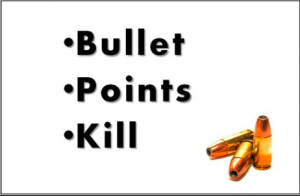Perhaps you’ve read this line:
“Eternal vigilance is the price of freedom.”
With apologies to its author (or authors), allow me to amend it:
“Eternal vigilance is the price of an inspired creative brief.”
While every question on a creative brief presents opportunities for missteps, one in particular routinely gets the best of brief writers. In other words, the answer to this question often leaves the readers of a brief scratching their heads, wondering why the answer is either fuzzy, incomplete or both.
The moral to this story is clear: Brief writers, stay vigilant!
Bullets kill, they don’t enlighten
Bullet points, that is. I cringe every time I read a creative brief that uses bullet points in the box reserved for describing the target audience of your product or service. 
Never use bullet points. Ever. This is the lazy brief-writer’s answer. It does no service to the creative team, the client, least of all the product.
Creatives require a rounded, three-dimensional picture of the person, or people, who is the potential user of the product. You can’t accomplish this with a list of bullet points. Which typically look like this (creatives, avert your eyes):
- HHI: $75-100K
- 45% male; 50% female; 5% politicians
- 30% HS education; 40% AA degree; 15% BA
A word picture, by contrast, breathes air and puts flesh and emotion into the air-breathing, fleshy, emoting human being who actually uses the product.
Remember this Indian proverb:
Tell me a fact, and I will learn. Tell me a truth, and I will believe. But tell me a story, and it will live forever in my heart.
Building a brand is about telling a story and triggering an emotional connection to the brand. It is not about pouring facts in a receptacle. This can only happen when you create a real portrait of the “target audience” for your creative team, which requires honesty and genuineness. And sometimes a sense of humor.

I’ve cited this example many times, including in my book. Take a look, and enjoy a great read. It is from a brief written by a Leo Burnett planner for a familiar Proctor & Gamble cold remedy, Vicks:
Cold sufferers. You know how you feel when you’ve got a cold—that pathetic little inner-child of yours suddenly wakes up and, before you know it, you’re moaning & whining, you’ve gone all whiney & wimpy, all snivel, snot & slovenly; red raw puffy eyes, pale skin, lank hair—everything seems to be sagging! You feel like something from a Salvador Dali painting; you want to snuggle up in bed and dammit—you want your Mummy! But it’s not fair, is it, because no one else takes your suffering seriously—”Good God, pull yourself together, man, we’re not talking leprosy here! Don’t be such a baby, get on with it, stop moaning!”
Yes, your instincts tell you to be a child, but you’re not allowed to because you’ve “only” (only!) got a cold. And worse still—oh, the cruel irony!—even your attempts to retain your adulthood in the midst of your suffering betrays that sniveling little inner–child of yours: “oh don’t worry about me, I’ll be all right…”, “…no, no, please, I don’t want to sound like a martyr…”, “…well, I’m feeling a little better now, thank you…”
I’m sorry, but when you’ve got a cold you’re doomed to be a Child–Adult.
Entertaining, yes? Of course it is. But put yourself in the shoes of a creative who has to conceive a message to someone who either doesn’t yet have a cold, but will certainly get one some day, or who in fact is already on death’s door and wants relief.
You instantly shove a creative’s work to a new level by this word-picture. You are now in the head (and snivel-ly nose) of the ideal customer for Vicks. You are inspired.
It’s your job, brief writer, to give your creative team a significant push in the right direction. Why not have fun in the process? Get them in the mood!
You can’t afford to give creatives a fast-food version of a haute-cuisine delectable like this Vicks brief writer’s piece of art. This brief raises the bar and communicates to the creative team what is expected of them.
When the bar gets raised at the creative-brief stage, where it should be set, expectations will (or should) be equally raised. That’s how it’s supposed to work. The brief becomes the measure for the work produced from it.
Eternal vigilance is the price a brief writer must pay to create a killer brief. Don’t get lazy. Your creative team depends on you.

